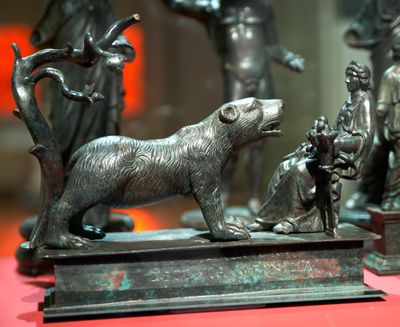アルティオ
アルティオ(Artio、ガロ・ローマ宗教ではDea Artio)はケルトの熊の女神である。特にスイスのベルンでは、彼女の崇拝の証が発見されている。彼女の名前は、ガリア語で「熊」を意味するartosに由来する[1]。
名前
アルティオ(Artiō)はケルト語で「熊」を意味するartos (cf. 古アイルランド語art, 中期ウェールズ語arth, 古ブルトン語ard) に由来し、原インド-ヨーロッパ語 *h₂ŕ̥tḱos (「熊」) から来ている。*Arto-rix(「熊王」)として再構築されたケルト語の形態は、ラテン語化した形態*Artori(u)sを介して、Arthurの名前の源である可能性がある。バスク語のhartz(「熊」)もケルト語の借用語であると推定される[2][3]。
概要
スイスのベルン近郊で発見されたムリ像群のブロンズ像には、椅子に座った女性と向かい合う大きな熊と、熊の背後にある小さな木が描かれている。女性は膝の上に果物を乗せているようで、熊に餌を与えているようだ[4][私注 1]。この彫刻は大きな長方形のブロンズの台座に、"Deae Artioni / Licinia Sabinilla"(「女神アルティオに」または「アルティオニス」、「リシニア・サビニラから」)の銘がある。名前がガリア語でも構文がラテン語の場合、dative Artioni とすると、i-stem nominative *Artionis か n-stem nominative *Artio が与えられることになる。
A bronze sculpture from the Muri statuette group, found near Bern in Switzerland, shows a large bear facing a woman seated in a chair, with a small tree behind the bear. The woman seems to hold fruit in her lap, perhaps feeding the bear. The sculpture has a large rectangular bronze base, which bears the inscription "Deae Artioni / Licinia Sabinilla" ("To the Goddess Artio" or "Artionis", "from Licinia Sabinilla"). If the name is Gaulish but the syntax is Latin, a dative Artioni would give an i-stem nominative *Artionis or an n-stem nominative *Artio. That would perhaps correspond to a Gaulish n-stem nominative *Artiu.
Other inscriptions to the goddess have been discovered in Daun (CIL 13, 4203), Weilerbach (CIL 13, 4113), Heddernheim (CIL 13, 7375 [4, p 125]), and Stockstadt (CIL 13, 11789).[5]
参考文献
- Bibliography
- Corpus Inscriptionum Latinarum (CIL) vol XIII, Inscriptiones trium Galliarum et Germaniarum
- テンプレート:Cite book
- Deyts, Simone (1992) Images des Dieux de la Gaule. Paris: Editions Errance. ISBN 2-87772-067-5.
- Green, Miranda (1992) Animals in Celtic Life and Myth. London: Routledge. ISBN 0-415-18588-2
- テンプレート:Cite book
- Wightman, E. M. (1970) Roman Trier and the Treveri London: Hart-Davis. ISBN 0-246-63980-6
私的注釈
- ↑ これは熊が世界のトーテムである、という図であると考える。
